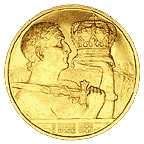|
 rowns are the quintessential
symbol of royal sovereignty. They have been used on coins since the 4th
century B.C. Crowns have taken many forms over time—Greek monarchs of
the Hellenistic age preferred simple diadems consisting of a cloth ribbon,
the Parthians developed an elaborate, jewel–encrusted crown which was
further elaborated by the Sassanian Persians into distinctive crowns for
each of their rulers, while the Romans used crowns to symbolize divinity
or to identify personifications of cities. By the 4th century A.D., Roman
Emperors were depicted wearing diadems, which, under the Byzantines, became
increasingly elaborate crowns. Medieval kingdoms adopted the idea of the
crown from the Byzantines and began to depict crowns on coins as they
got larger and craftsmanship improved.Crowns have remained on coins ever
since, often used to explicitly highlight the autocratic nature of the
issuing authority as in the gold coin of Carol II of Romania below. rowns are the quintessential
symbol of royal sovereignty. They have been used on coins since the 4th
century B.C. Crowns have taken many forms over time—Greek monarchs of
the Hellenistic age preferred simple diadems consisting of a cloth ribbon,
the Parthians developed an elaborate, jewel–encrusted crown which was
further elaborated by the Sassanian Persians into distinctive crowns for
each of their rulers, while the Romans used crowns to symbolize divinity
or to identify personifications of cities. By the 4th century A.D., Roman
Emperors were depicted wearing diadems, which, under the Byzantines, became
increasingly elaborate crowns. Medieval kingdoms adopted the idea of the
crown from the Byzantines and began to depict crowns on coins as they
got larger and craftsmanship improved.Crowns have remained on coins ever
since, often used to explicitly highlight the autocratic nature of the
issuing authority as in the gold coin of Carol II of Romania below.
|

![]() rowns are the quintessential
symbol of royal sovereignty. They have been used on coins since the 4th
century B.C. Crowns have taken many forms over time—Greek monarchs of
the Hellenistic age preferred simple diadems consisting of a cloth ribbon,
the Parthians developed an elaborate, jewel–encrusted crown which was
further elaborated by the Sassanian Persians into distinctive crowns for
each of their rulers, while the Romans used crowns to symbolize divinity
or to identify personifications of cities. By the 4th century A.D., Roman
Emperors were depicted wearing diadems, which, under the Byzantines, became
increasingly elaborate crowns. Medieval kingdoms adopted the idea of the
crown from the Byzantines and began to depict crowns on coins as they
got larger and craftsmanship improved.Crowns have remained on coins ever
since, often used to explicitly highlight the autocratic nature of the
issuing authority as in the gold coin of Carol II of Romania below.
rowns are the quintessential
symbol of royal sovereignty. They have been used on coins since the 4th
century B.C. Crowns have taken many forms over time—Greek monarchs of
the Hellenistic age preferred simple diadems consisting of a cloth ribbon,
the Parthians developed an elaborate, jewel–encrusted crown which was
further elaborated by the Sassanian Persians into distinctive crowns for
each of their rulers, while the Romans used crowns to symbolize divinity
or to identify personifications of cities. By the 4th century A.D., Roman
Emperors were depicted wearing diadems, which, under the Byzantines, became
increasingly elaborate crowns. Medieval kingdoms adopted the idea of the
crown from the Byzantines and began to depict crowns on coins as they
got larger and craftsmanship improved.Crowns have remained on coins ever
since, often used to explicitly highlight the autocratic nature of the
issuing authority as in the gold coin of Carol II of Romania below.



